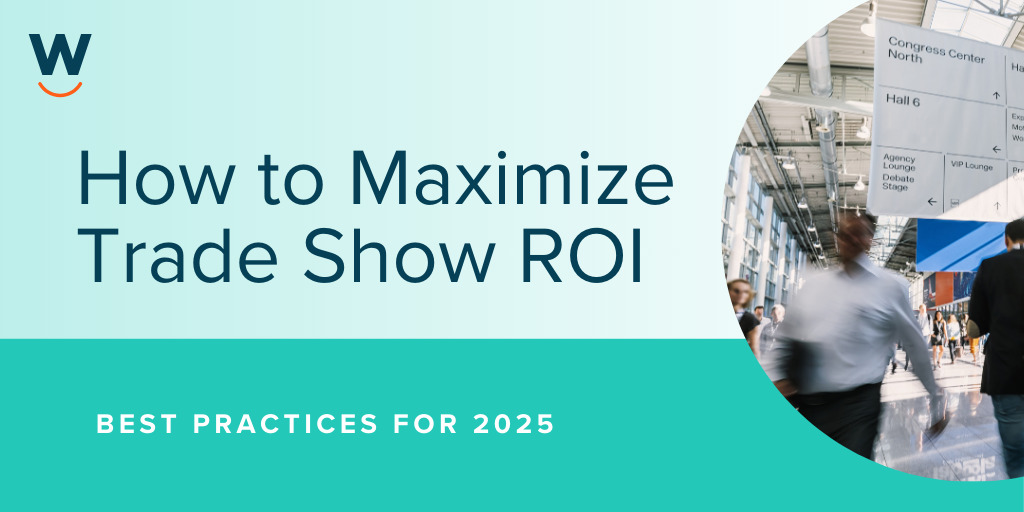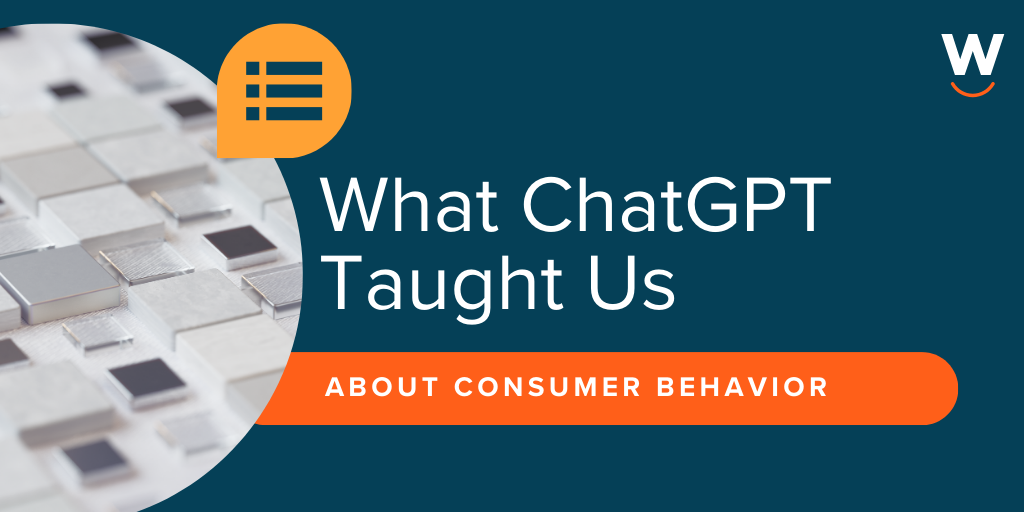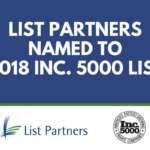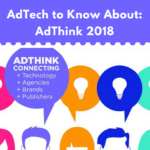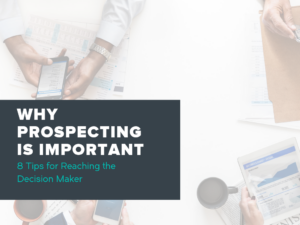
Why Prospecting Is Important: Eight Tips For Reaching the Decision Maker
Updated: June 6, 2019
You might be thinking, “Why is prospecting important for sales?” First, it’s important to answer the question: what is prospecting? Prospecting, the first step in the sales cycle, is the process of identifying and connecting with potential customers. The goal of prospecting is to build a sales pipeline, wherein a salesperson consistently connects with a potential customer to develop a rapport with the intention of eventually, closing a sale.
You may be thinking, is prospecting really essential to your company and team success? Maybe you’ve got your eyes set on a few big-name partners to buy a majority of your available inventory and don’t think that traditional prospecting is really applicable for your business. Perhaps you don’t know or care why prospecting is important, because you’ve got a lot going on. Lean teams and big expectations are a dime-a-dozen in the sponsorship world, and we’re willing to bet that you’re pretty busy.
Prospecting isn’t optional if you want to be successful in the sales world.
Why prospecting is important
Unfortunately, sales are rarely easy to close; similarly, identifying potential customers and connecting in a meaningful and NOT-predatorily sales-y way is actually really challenging! Luckily, we at Winmo are here to provide some insights and tips to ease the prospecting pain and help you reach all of your wildest sponsorship sales goals and beyond.
Prospecting is important because it creates more opportunity. Think of this way: it takes time to convert a prospect to a sale and can be particularly tricky in a sponsorship context. To maximize your assets and sell to your goal (and beyond), you need to start building a sales pipeline for potential partners early and build upon it often.
Still skeptical as to how and why prospecting is important? Because ball don’t lie (and data doesn’t, either):
- According to Hubspot, customers or brand partners want to hear from sales and partnership representatives early, particularly when they’re looking for opportunities to improve their business (71%) or trying to solve a problem (62%).
- Eight in 10 decision-makers preferred email communication, so make sure your subject line game is on-point and that your copy is tailored to potential partners. Sales can require more buy-in than something like, say, a Winmo free trial. Hurdle the buy-in issue with personalized outreach!
- When asked why customers were willing to have a conversation, 64% said available budget! That means that timing is critical to your success. If you’re a Winmo user, we recommend using the filtering tools in search to discern what brands are planning right now, in Q3 (a little free info: it’s 2,234 brands), and design your prospecting funnel around planning periods so that you can strike while the iron is heating up.
- Buyers and potential customers want to know who they’re talking to before they actually dive into a deeper conversation. Over 80% of surveyed buyers said that they check a salesperson’s LinkedIn page before replying to an outreach email, so optimize that profile! Check out Hubspot’s LinkedIn recommendations here.
Now that we’ve covered the prospecting basics, let’s dive into eight tips for sales prospecting.
Eight tips for reaching decision makers
1) Define your audience.
The process of prospecting can be overwhelming — Winmo has over 32,000 brand contacts! By defining the characteristics of your ideal partners, you can utilize search functionality to build a list that suits your needs, and narrow the field to something more manageable. Not using Winmo? The same advice applies. (Though we also recommend requesting your free trial to get a feel for what you’re missing.)
2) Tailor your email subject line to your prospect.
If we’ve said it once, we’ve said it 21 ways. You won’t get anywhere with an email that decision makers don’t care to open. Optimize, personalize, and reach out with confidence.
3) Strike while the iron is heating up.
Not when the iron is already hot. The timelines people in like aren’t just punctual, they’re early. Rip a page out of that book, and consider, “If you’re on time, you’re late,” your new sales mantra, because, in this business, timing is everything. Rather than waiting for agency reviews to be announced or RFPs to be sent out, target clients who are preparing to dump current partners with WinmoEdge’s predictive sales intelligence. With a 74% accuracy rate, WinmoEdge will help you prospect clients that are in the search mindset.
4) Make prospecting a habit.
Prospecting is like exercise: the more you do it, the easier it gets. Getting in touch with a prospect is like winning the lottery, so it’s vital that you up your chances by reaching out regularly. We recommend blocking out a couple hours each day to update lists, craft emails, and follow up with potential prospects. You read that right: every day.
5) Find a commonality.
In sponsorship sales, there’s a unique opportunity to personalize your pitch to your non-profit, event, etc. Use that personalization to your advantage by finding a commonality with your prospects. It’s a known fact that people are hardwired to like people who seem similar, so use this to your advantage; we recommend using social media, LinkedIn, and professional bios to get a sense of who you’re emailing. Or, if you’re a Winmo member, use the custom Crystal Knows information to personalize your outreach efforts.
6) Track your rejections.
While we don’t generally recommend focusing on the negative, in prospecting, we recommend keeping track of the contacts that say no, and their reasons for doing so. This process will help you refine your pitch to common concerns, and will ultimately get you that much closer to your “yes.”
7) Utilize Influencers.
One of the biggest mistakes salespeople make is only reaching out to top-level executives. While Vice President and C-Suite executives typically have the final say, they are also the ones whose inboxes are most inundated. The influencer is an important person to impress because they are the ones who would greatly benefit from finding the right tool or service to take their work to the next level. After capturing the influencer’s attention, they can then create a proposal for their boss and the ultimate decision-maker.
8) Understand company size.
Depending how large or small a company is, different titles may have different responsibilities. For example, a smaller business has fewer gatekeepers, meaning you will want to approach the CEO or a member of the C-Suite. For larger businesses, the best contact may be slightly lower on the totem pole. Ultimately, the size of the company determines the types of titles to approach, and also suggests certain challenges the company may be able to overcome through using your product.
What are the benefits of prospecting?
- More customers: The average salesperson loses about 15 to 20 percent of their customer base each year due to gradual attrition. Without prospecting, there are no leads to fill these gaps. In the game of sales, it’s important to have more customers waiting in the case of a lost sale.
- Increased revenue: As you are well aware, more customers leads to more revenue. It’s crucial to consistently have a forward-thinking mindset and opportunities filling your pipeline.
- Qualification: Prospecting presents a salesperson with the opportunity to understand whether a customer is qualified for their service or product. Qualifying potential prospects will create a more efficient selling system and ultimately improve your sales process as a whole.
- Data Gathering: While prospecting may not always lead to an immediate sale, it is a source of data and a chance to conduct market research. Prospecting can answer questions such as why people buy your product, what they think of your approach, what their goals are, and assist salespeople in determining the best way to sell their product.
If you liked this blog post, check out:
- Sales Prospecting: How to Write Better Cold Call Emails
- 8 Takeaways From The Wolf of Wall Street
- Time Saving Tips for B2B Sales Prospecting


